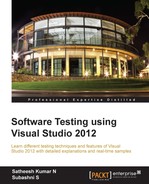Software testing is one of the most important phases of the software development life cycle (SDLC). Delivery of the software product is based on following good SDLC practices of analysis, design, coding, testing, and by all means meeting the customer requirements. The quality of the product is measured by verifying and validating the product based on the defined functional and non-functional requirements for product. The testing tools and techniques play an important role in simulating the real-life scenarios and the user load required for verifying the stability and reliability of the product. For example, testing a web application with 1,000 concurrent users is a very time consuming and tedious task, if we do it manually considering the required resources. But the testing tools that are part of Visual Studio 2012 can simulate such scenarios and test it with limited resources and without manual intervention during testing. Visual Studio 2012 provides tools to conduct different types of testing, such as Unit testing, Load testing, Web testing, Ordered testing, Generic testing, and Exploratory testing.
This chapter covers the following topics and provides a high-level overview of the testing tools and techniques supported by Visual Studio 2012:
- Testing as part of the software development life cycle
- Types of testing
- Test management in Visual Studio 2012
- Testing tools in Visual Studio 2012
Before getting into the details of how to perform testing using Visual Studio 2012, let us familiarize different tools provided by Visual Studio 2012 and its usage. Visual Studio provides tools for testing as well as test management such as the Test List Editor and the Test View. The Test Projects and the actual test files are maintained in Team Foundation Server (TFS) for managing the version control of the source and history of changes.
The other aspect of this chapter is exploring the different file types generated in Visual Studio during testing. Most of these files are in the XML format, which are created automatically whenever a new test is created.
For readers new to Visual Studio, there is a brief overview on each window we are going to deal with throughout all or most of the chapters in this book. While we go through the windows and their purposes, we can check the Integrated Development Environment (IDE) and the tools integration with Visual Studio 2012.
Microsoft Visual Studio 2012 has different editions tailored to the needs. You need to have the respective edition as prerequisite to use any of the testing features explained in this book. The following table shows supported edition of Visual Studio 2012 for the testing features.
|
Testing features |
Ultimate with MSDN |
Premium with MSDN |
Test Professional with MSDN |
Professional with MSDN |
Professional |
|---|---|---|---|---|---|
|
Yes |
Yes |
Yes |
Yes | ||
|
Yes |
Yes | ||||
|
Yes |
Yes | ||||
|
Yes |
Yes |
Yes | |||
|
Yes |
Yes |
Yes | |||
|
Yes |
Yes |
Yes | |||
|
Yes | |||||
|
Yes |
Yes |
Yes |
Microsoft Test Manager 2012 (MTM) is a standalone product from Microsoft, which integrates with Team Foundation Server for test management. MTM is used in creating and managing multiple Test Plans, cloning Test Plans, creating Test Suites, creating manual test steps and test cases, and maintaining the same. MTM also provides various reports for Test Plan results. In 2012 version, MTM has the new feature of exploratory testing, maintaining records, and test steps during exploratory testing.
Lab environments can be created in MTM using the controller and agents. This is required when running load tests with multiple agents.
